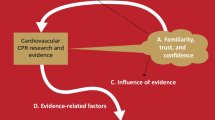Summary
Aim
Explain how research can advance the state-ofthe- practice in percutaneous coronary intervention (PCI).
Methods and results
Identifying the success factors of PCI; identifying decision- making performance (power of judgement) as the factor that could be advanced faster than is currently the case; explaining why and how such advancement needs a different research approach than those currently pursued in medical research; presenting initial results of this approach in the form of a set of basic concepts (pivoting around risk) that are useful for describing the decision-making process during a PCI.
Conclusion
Building a terminology (ontology) of PCI decision-making concepts and then eliciting expert knowledge about the decision-making process itself are promising ways of advancing the teachability of PCI and hence the state-of-thepractice.
Similar content being viewed by others
References
Grüntzig A, Riedhammer HH, Turina M, Rutishauser W (1976) Eine neue Methode zur perkutanen Dilatation von Koronarstenosen. Tierexperimentelle Prüfung. Verh Dtsch Ges Kresl Forsch 42:282–285
Cohen HA, Williams DO, Holmes DR Jr et al (2003) Impact of age on procedural and 1-year outcome in percutaneous transluminal coronary angioplasty: A report from the NHLBI dynamic registry. Am Heart J 146:513–519
Togni M, Balmer F, Pfiffner D et al (2004) Percutaneous coronary interventions in Europe 1992–2001. Eur Heart J 25:1208–1213
Chalmers I, Matthews R (2006) What are the implications of optimism bias in clinical research. Lancet 367:449–450
Nagle PC, Smith AW (2004) Review of recent US cost estimates of revascularization. Am J Manag Care 10:S370–376
National medical malpractice statistics. http://www.medicalmalpractice. com/National-Medical-Malpractice- Facts.cfm (February 9, 2006)
Prechelt L, Lanzer P (2006) The decision- making process in percutaneous coronary interventions. In: Lanzer P (ed) Mastering endovascular techniques. Guide to excellence. Lippincott, Williams & Wilkins, Philadelphia, pp 103–113
Patel VL, Arocha JF, Kaufman DR (1998) Expertise and tacit knowledge in medicine. In: Sternberg RJ, Horvath JA (eds) Tacit Knowledge in Professional Practice: Researcher and Practitioner Perspectives. Lawrence Erlbaum Associates, p 75–100
Klir GJ, Yuan B (1995) Fuzzy sets and fuzzy logic: theory and applications. Prentice-Hall
Topoleski T (2002) Atherosclerotic lesions: mechanical properties. In: Lanzer P, Topol EJ (eds) PanVascular medicine; Integrated clinical management. Springer, New York Berlin, pp 340–352
Mitchell TM (1997) Machine learning. McGraw Hill
Menzies T (2002) Knowledge elicitation: the state of the art. In: Chang SK (ed) Handbook of Software Engineering and Knowledge Engineering, Vol 2. World Scientific Publishing Company, pp 607–628
Author information
Authors and Affiliations
Corresponding author
Rights and permissions
About this article
Cite this article
Prechelt, L., Lanzer, P. On understanding the power of judgement in percutaneous coronary intervention. Clin Res Cardiol 96, 199–203 (2007). https://doi.org/10.1007/s00392-007-0485-0
Received:
Accepted:
Published:
Issue Date:
DOI: https://doi.org/10.1007/s00392-007-0485-0




